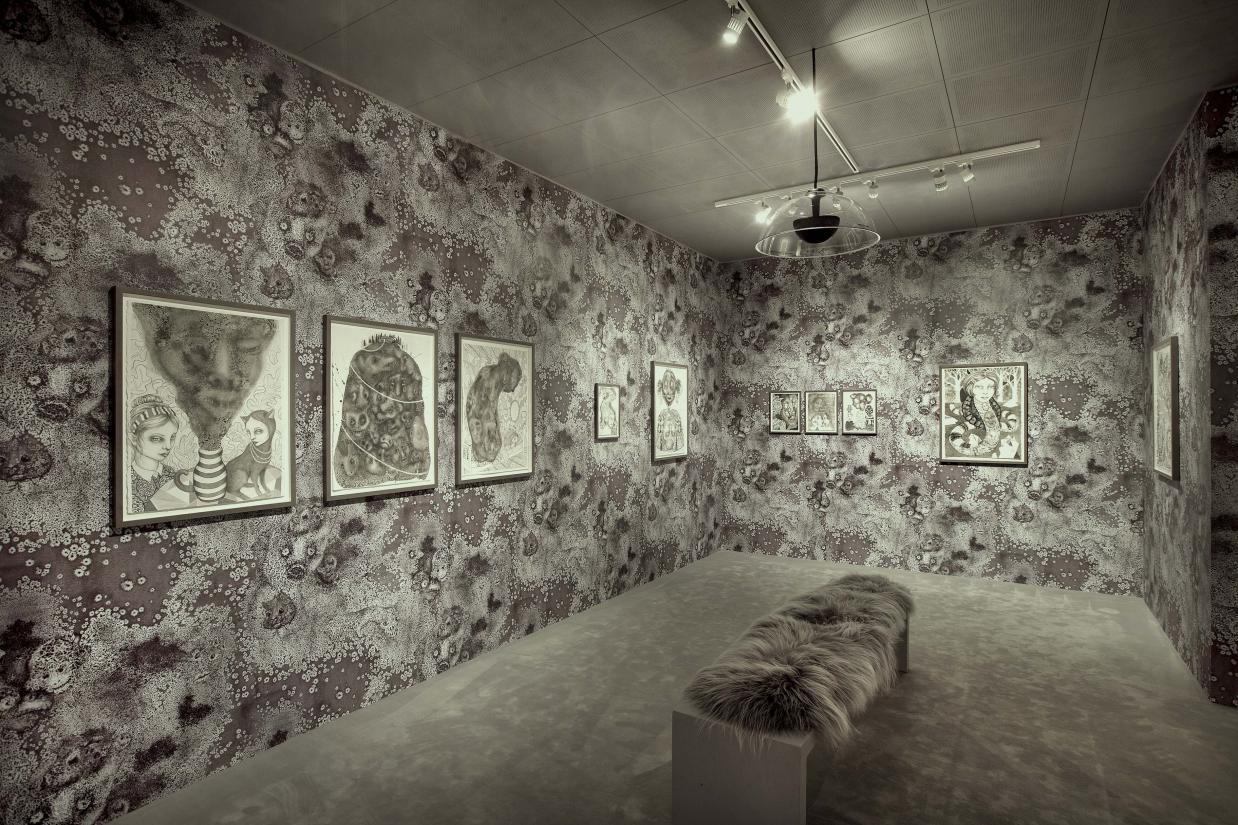Trapholt Museum of Modern Art and Design has followed visual artist Julie Nord’s practice closely with the desire of exhibiting and collecting her works. The museum’s exhibition ERUPTION, which recently closed, presented her series Gråzone (Grey Zone), which was presented in a total installation. The fifteen images that make up the series are now included in the museum’s permanent collection thanks to funding from the New Carlsberg Foundation.
Nord’s universe in three dimensions
Julie Nord’s preferred medium is drawing, where she unfolds a detailed and fantastical universe inhabited by mystical figures occupying the space between the realistic and the supernatural. The artist derives themes from both pop culture and the world of art, which she combines, driven by a particular fascination with the subconscious and the boundaries between real life and fantasy. On the one hand, her universe has a disturbing quality – on the other, it is also imbued with a quirky humour.
At Trapholt, Gråzone was hung in an atmospheric total installation, and the audience was invited into dimly lit rooms with grey-patterned walls that seemed to extend the artistic universe beyond the picture frames and immerse the visitors in Nord’s world – a dream-world where human bodies sprout animal parts, and spirits float out of everyday objects.
The Rorschach method
Typically, Julie Nord begins her process by doodling as she begins to define her motif. Next, she draws loosely in pencil, constructing the images incrementally, one element at the time. In Gråzone, Julie Nord relinquished control, opting for a distinctly different approach, as Trapholt’s director, Karen Grøn, explains. In this instance, her process sprang from a spilled inkblot mixed with water which she sprinkled salt on. This produced a crystalline expression reminiscent of clouds.
‘Just as when you look at clouds in the sky, making out faces and figures, Julie Nord subsequently drew out the creatures that emerged from the inkblot. This explorative process resulted both in the wallpaper that envelops the total installation and in the artworks hung on the walls,’ says Karen Grøn.
‘This was the subconscious at work, as when the Swiss psychologist Hermann Rorschach developed his famous psychological test in the 1960s, designed to diagnose mental disorders based on the images the person perceived in an inkblot.’
Julie Nord’s process in Gråzone plays on the tension between the artistic intention and the uncontrolled and random element that reflects those cracks in real life that reveal what lies behind the facade of normalcy. ‘She views these cracks as liberating and vitalizing – even if what they reveal isn’t always pretty. She creates works of art that are simultaneously shrill, sentimental and refreshingly eerie,’ the director concludes.

![Julie Nord: Gråzone [Grey Area], 2016.](/sites/default/files/styles/slider_full/public/2018-05/Graazone%202_0.jpg?itok=cb6uA52-)
![Julie Nord: Gråzone [Grey Area], 2016.](/sites/default/files/styles/slider_full/public/2018-05/Graazone%203_0.jpg?itok=79CBxQF2)
![Julie Nord: Gråzone [Grey Area], 2016.](/sites/default/files/styles/slider_full/public/2018-05/Graazone%204_1.jpg?itok=qZitBYxG)
![Julie Nord: Gråzone [Grey Area], 2016.](/sites/default/files/styles/slider_full/public/2018-05/Graazone%205_0.jpg?itok=8GwUHCh9)
![Julie Nord: Gråzone [Grey Area], 2016.](/sites/default/files/styles/slider_full/public/2018-05/Graazone%206_0.jpg?itok=d5SG9TVz)


